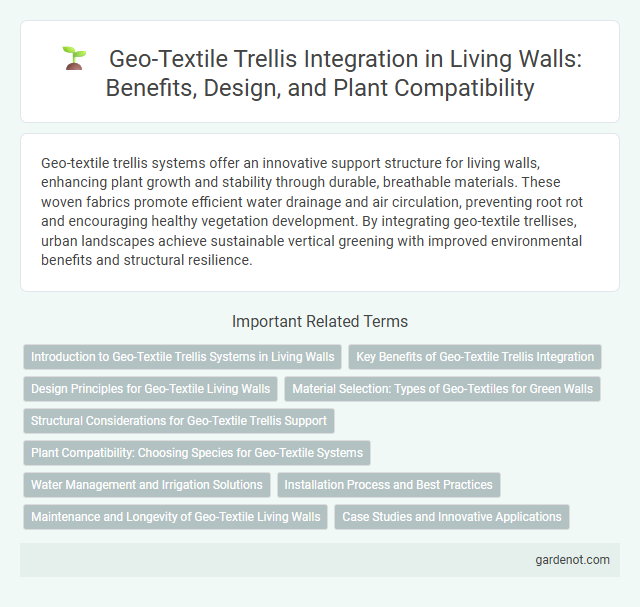Geo-textile trellis systems offer an innovative support structure for living walls, enhancing plant growth and stability through durable, breathable materials. These woven fabrics promote efficient water drainage and air circulation, preventing root rot and encouraging healthy vegetation development. By integrating geo-textile trellises, urban landscapes achieve sustainable vertical greening with improved environmental benefits and structural resilience.
Introduction to Geo-Textile Trellis Systems in Living Walls
Geo-textile trellis systems in living walls provide a durable and breathable substrate ideal for supporting climbing plants and vertical greenery. These systems use synthetic, permeable fabrics that encourage root aeration and water drainage, enhancing plant health and wall longevity. Engineered for urban environments, geo-textile trellises combine environmental sustainability with structural stability, making them a popular choice for modern green architecture.
Key Benefits of Geo-Textile Trellis Integration
Geo-textile trellis integration enhances living walls by providing superior root support and improved water retention, promoting healthier plant growth. Its porous structure facilitates efficient drainage and aeration, preventing soil erosion and root suffocation. This sustainable solution also increases durability and reduces maintenance costs, making it ideal for long-term vertical gardening projects.
Design Principles for Geo-Textile Living Walls
Geo-textile trellises for living walls utilize lightweight, permeable fabrics that support plant growth by facilitating root aeration and water drainage. Design principles emphasize selecting durable, UV-resistant geo-textiles tailored to the specific plant species and environmental conditions to ensure long-term stability and health. Incorporating modular panels with integrated irrigation systems optimizes moisture retention and promotes uniform growth across the vertical surface.
Material Selection: Types of Geo-Textiles for Green Walls
Geo-textile trellises for living walls commonly utilize non-woven polypropylene for its durability, water permeability, and resistance to UV degradation. Woven geo-textiles made from high-density polyethylene offer superior tensile strength, ideal for supporting heavy plant growth in vertical gardens. Selecting the appropriate geo-textile material maximizes structural support and promotes healthy root aeration and moisture retention essential for thriving green walls.
Structural Considerations for Geo-Textile Trellis Support
Geo-textile trellis systems provide essential structural support for living walls by distributing load evenly and enhancing stability. The material's tensile strength and permeability ensure adequate root aeration and water drainage, preventing soil compaction and promoting healthy plant growth. Anchoring techniques and compatibility with wall substrates are critical to maintaining long-term durability and resisting environmental stresses.
Plant Compatibility: Choosing Species for Geo-Textile Systems
Selecting plant species compatible with geo-textile trellis systems is crucial for optimal growth and structural integrity. Vining plants such as ivy, climbing hydrangea, and clematis thrive on geo-textile substrates due to their lightweight nature and ability to anchor securely. Species with moderate root spread and durability against wind stress enhance longevity and reduce maintenance in living wall installations.
Water Management and Irrigation Solutions
Geo-textile trellises enhance living wall water management by promoting efficient irrigation distribution and improving moisture retention within substrate layers. Their porous structure facilitates optimal drainage and prevents waterlogging, ensuring plant roots receive balanced hydration. Integrating geo-textile materials with drip irrigation systems maximizes water use efficiency and supports sustainable urban green wall designs.
Installation Process and Best Practices
Geo-textile trellises are installed by first securing a durable, UV-resistant geo-textile fabric to a supporting frame, ensuring it is taut and well-anchored for optimal plant support. Best practices include selecting breathable, water-permeable geo-textiles to promote healthy root growth and prevent waterlogging, and pre-irrigating the substrate to maintain consistent moisture levels during initial plant establishment. Proper spacing of plantings on the trellis and regular maintenance checks are essential to maximize vertical growth and structural integrity of the living wall system.
Maintenance and Longevity of Geo-Textile Living Walls
Geo-textile trellises enhance the durability of living walls by providing robust support that resists weathering and physical stress. Regular inspections ensure proper attachment and prevent fabric deterioration, while periodic cleaning removes debris that can cause mold or mildew growth. Utilizing UV-resistant geo-textile materials significantly extends the lifespan, maintaining structural integrity and promoting healthy plant growth.
Case Studies and Innovative Applications
Geo-textile trellises have revolutionized living wall installations by enhancing structural stability and promoting superior plant growth in urban environments. Case studies demonstrate their effectiveness in large-scale vertical gardens, where these engineered fabrics improve water retention and root support while reducing maintenance costs. Innovative applications include integrating geo-textiles with smart irrigation systems and lightweight modular frameworks, optimizing both environmental sustainability and aesthetic appeal.
Geo-textile trellis Infographic

 gardenot.com
gardenot.com